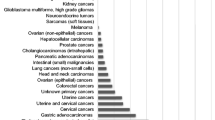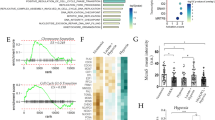Abstract
Background
Isocitrate dehydrogenase (IDH) is an important enzyme that oxidatively decarboxylates isocitrate to α-ketoglutarate, and three isoforms (IDH1-3) have been identified. Overexpression and/or downregulation of IDH isoforms was reported in several human malignancies, suggesting importance of IDH in oncogenesis. However, significance of IDH isoforms remains largely unclear in the breast carcinoma.
Methods
We immunolocalized IDH1, IDH2 and IDH3α in 226 breast carcinomas and evaluated their clinical significance. Subsequently, we examined effects of IDH2 on proliferation in breast carcinoma cells.
Results
Immunoreactivity of IDH1-3α was detected in 53%, 38% and 41% of breast carcinomas, and the non-neoplastic epithelium was IDH1-positive, IDH2-negative and IDH3α-positive. IDH1 immunoreactivity was inversely associated with pathological T factor (pT) and Ki-67 in the breast carcinoma, while IDH3α immunoreactivity was not significantly associated with clinicopathological factors. IDH2 status was positively correlated with stage, pT, histological grade, HER2, Ki-67 and microvessel density. Moreover, IDH2 status was significantly associated with worse prognosis of the patients, and it turned out an independent prognostic factor for estrogen-receptor (ER) positive patients. These findings were more evident in the IDH1-negative / IDH2-positive/IDH3α-negative subgroup which is the opposite immunohistochemical IDH phenotype of normal mammary epithelium. In vitro studies demonstrated that RNA interference of IDH2 significantly decreased proliferation activity of T47D and SKBR-3 cells.
Conclusion
These results suggest that IDH2 is associated with an aggressive phenotype of breast carcinoma through increasing cell proliferation, different from IDH1 and IDH3α, and immunohistochemical IDH2 status is a potent prognostic factor especially in ER-positive breast cancer patients.



Similar content being viewed by others
References
Fisher B, Anderson SJ. The breast cancer alternative hypothesis: is there evidence to justify replacing it? J Clin Oncol. 2010;28:366–74. https://doi.org/10.1200/JCO.2009.26.8292.
Muftah AA, Aleskandarany MA, Al-Kaabi MM, Sonbul SN, Diez-Rodriguez M, Nolan CC, et al. Ki67 expression in invasive breast cancer: the use of tissue microarrays compared with whole tissue sections. Breast Cancer Res Treat. 2017;164:341–8. https://doi.org/10.1007/s10549-017-4270-0.
Djalalov S, Beca J, Amir E, Krahn M, Trudeau ME, Hoch JS. Economic evaluation of hormonal therapies for postmenopausal women with estrogen receptor-positive early breast cancer in Canada. Curr Oncol. 2015;22:84–96. https://doi.org/10.3747/co.22.2120.
Tevaarwerk AJ, Gray RJ, Schneider BP, Smith ML, Wagner LI, Fetting JH, et al. Survival in patients with metastatic recurrent breast cancer after adjuvant chemotherapy: little evidence of improvement over the past 30 years. Cancer. 2013;119:1140–8. https://doi.org/10.1002/cncr.27819.
Sato A, Takagi K, Miki Y, Yoshimura A, Hara M, Ishida T, et al. Cytochrome c1 as a favorable prognostic marker in estrogen receptor-positive breast carcinoma. Histol Histopathol. 2019;34:1365–75. https://doi.org/10.14670/HH-18-130.
Bergaggio E, Piva R. Wild-type IDH enzymes as actionable targets for cancer therapy. Cancers (Basel). 2019;11:563. https://doi.org/10.3390/cancers11040563.
Geisbrecht BV, Gould SJ. The human PICD gene encodes a cytoplasmic and peroxisomal NADP(+)-dependent isocitrate dehydrogenase. J Biol Chem. 1999;274:30527–33. https://doi.org/10.1074/jbc.274.43.30527.
Ma T, Peng Y, Huang W, Liu Y, Ding J. The β and γ subunits play distinct functional roles in the α2βγ heterotetramer of human NAD-dependent isocitrate dehydrogenase. Sci Rep. 2017;7:41882. https://doi.org/10.1038/srep41882.
Huang J, Yu J, Tu L, Huang N, Li H, Luo Y. Isocitrate dehydrogenase mutations in glioma: from basic discovery to therapeutics development. Front Oncol. 2019;9:506. https://doi.org/10.3389/fonc.2019.00506.
Bleeker FE, Lamba S, Leenstra S, Troost D, Hulsebos T, Vandertop WP, et al. IDH1 mutations at residue p. R132 (IDH1(R132)) occur frequently in high-grade gliomas but not in other solid tumors. Hum Mutat. 2009;30:7–11. https://doi.org/10.1002/humu.20937.
Raynaud S, Carbuccia N, Colin C, Adélaïde J, Mozziconacci MJ, Metellus P, et al. Absence of R140Q mutation of isocitrate dehydrogenase 2 in gliomas and breast cancers. Oncol Lett. 2010;1:883–4. https://doi.org/10.3892/ol_00000156.
Zeng L, Morinibu A, Kobayashi M, Zhu Y, Wang X, Goto Y, et al. Aberrant IDH3α expression promotes malignant tumor growth by inducing HIF-1-mediated metabolic reprogramming and angiogenesis. Oncogene. 2015;34:4758–66. https://doi.org/10.1038/onc.2014.411.
Liu WS, Chan SH, Chang HT, Li GC, Tu YT, Tseng HH, et al. Isocitrate dehydrogenase 1-snail axis dysfunction significantly correlates with breast cancer prognosis and regulates cell invasion ability. Breast Cancer Res. 2018;20:25. https://doi.org/10.1186/s13058-018-0953-7.
Aljohani AI, Toss MS, Kurozumi S, Joseph C, Aleskandarany MA, Miligy IM, et al. The prognostic significance of wild-type isocitrate dehydrogenase 2 (IDH2) in breast cancer. Breast Cancer Res Treat. 2020;179:79–90. https://doi.org/10.1007/s10549-019-05459-7.
Mayama A, Takagi K, Suzuki H, Sato A, Onodera Y, Miki Y, et al. OLFM4, LY6D and S100A7 as potent markers for distant metastasis in estrogen receptor-positive breast carcinoma. Cancer Sci. 2018;109:3350–9. https://doi.org/10.1111/cas.13770.
Hammond ME, Hayes DF, Dowsett M, Allred DC, Hagerty KL, Badve S, et al. American Society of Clinical Oncology/College of American Pathologists guideline recommendations for immunohistochemical testing of estrogen and progesterone receptors in breast cancer (unabridged version). Arch Pathol Lab Med. 2010;134:e48-72.
Sato-Tadano A, Suzuki T, Amari M, Takagi K, Miki Y, Tamaki K, et al. Hexokinase II in breast carcinoma: a potent prognostic factor associated with hypoxia-inducible factor-1α and Ki-67. Cancer Sci. 2013;104:1380–8. https://doi.org/10.1111/cas.12238.
Krishnapriya S, Malipatil B, Surekha S, Sundersingh S, Sridevi V, Ananthi B, et al. Microvessel density (MVD) in locally advanced breast cancer. Asian Pac J Cancer Prev. 2019;20:1537–45. https://doi.org/10.31557/APJCP.2019.20.5.1537.
Goldhirsch A, Wood WC, Coates AS, Gelber RD, Thurlimann B, Senn HJ. Strategies for subtypes–dealing with the diversity of breast cancer: highlights of the St. Gallen International Expert Consensus on the Primary Therapy of Early Breast Cancer 2011. Ann Oncol. 2011;22:1736–47. https://doi.org/10.1093/annonc/mdr304.
Dai X, Cheng H, Bai Z, Li J. Breast cancer cell line classification and its relevance with breast tumor subtyping. J Cancer. 2017;8:3131–41. https://doi.org/10.7150/jca.18457.
Takagi K, Miki Y, Onodera Y, Ishida T, Watanabe M, Sasano H, et al. ARHGAP15 in human breast carcinoma: a potent tumor suppressor regulated by androgens. Int J Mol Sci. 2018;19:804. https://doi.org/10.3390/ijms19030804.
Ward PS, Patel J, Wise DR, Abdel-Wahab O, Bennett BD, Coller HA, et al. The common feature of leukemia-associated IDH1 and IDH2 mutations is a neomorphic enzyme activity converting alpha-ketoglutarate to 2-hydroxyglutarate. Cancer Cell. 2010;17:225–34. https://doi.org/10.1016/j.ccr.2010.01.020.
Yan H, Parsons DW, Jin G, McLendon R, Rasheed BA, Yuan W, et al. IDH1 and IDH2 mutations in gliomas. N Engl J Med. 2009;360:765–73. https://doi.org/10.1056/NEJMoa0808710.
Torrens-Mas M, Pons DG, Sastre-Serra J, Oliver J, Roca P. SIRT3 silencing sensitizes breast cancer cells to cytotoxic treatments through an increment in ROS production. J Cell Biochem. 2017;118:397–406. https://doi.org/10.1002/jcb.25653.
Wang Z, Liang S, Lian X, Liu L, Zhao S, Xuan Q, et al. Identification of proteins responsible for adriamycin resistance in breast cancer cells using proteomics analysis. Sci Rep. 2015;5:9301. https://doi.org/10.1038/srep09301.
Koseki J, Colvin H, Fukusumi T, Nishida N, Konno M, Kawamoto K, et al. Mathematical analysis predicts imbalanced IDH1/2 expression associates with 2-HG-inactivating β-oxygenation pathway in colorectal cancer. Int J Oncol. 2015;46:1181–91. https://doi.org/10.3892/ijo.2015.2833.
Acknowledgements
This work was partly supported by JSPS KAKENHI Grant Number 19K09065 and 19K07410.
Author information
Authors and Affiliations
Contributions
HM performed immunohistochemical experiments and prepared the manuscript. KT contributed the experimental design and performed statistical analysis. AS performed in vitro experiments. MY, CH and YM gave skillful suggestions of immunohistochemistry and in vitro studies. NH-S and MM collected and managed clinical information of the patients. HS collected and managed pathological information and specimens examined. TS contributed the study conception and performed immunohistochemical evaluation.
Corresponding author
Ethics declarations
Conflicts of interest
The authors declare that they have no conflict of interest.
Research involving Human participants and/or Animals
All procedures performed in studies involving human participants were in accordance with the ethical standards of the Ethics Committee at Tohoku University Graduate School of Medicine and with the 1964 Helsinki declaration and its later amendments or comparable ethical standards. For this type of study formal consent is not required. This article does not contain any studies with animals performed by any of the authors.
Informed consent
The design of this study is retrospective study and informed consent is not required.
Additional information
Publisher's Note
Springer Nature remains neutral with regard to jurisdictional claims in published maps and institutional affiliations.
Supplementary Information
Below is the link to the electronic supplementary material.
About this article
Cite this article
Minemura, H., Takagi, K., Sato, A. et al. Isoforms of IDH in breast carcinoma: IDH2 as a potent prognostic factor associated with proliferation in estrogen-receptor positive cases. Breast Cancer 28, 915–926 (2021). https://doi.org/10.1007/s12282-021-01228-x
Received:
Accepted:
Published:
Issue Date:
DOI: https://doi.org/10.1007/s12282-021-01228-x




